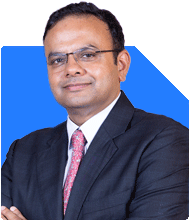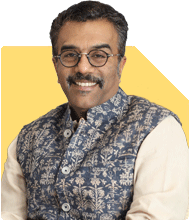Ramalingam Kalirajan |10902 Answers |Ask -Follow
Mutual Funds, Financial Planning Expert - Answered on May 06, 2024
He has an MBA in finance from the University of Madras and is a certified financial planner.
He is the director and chief financial planner at Holistic Investment, a Chennai-based firm that offers financial planning and wealth management advice.... more

I am 33 years old and I have created corpus of 40 Lacs. My current monthly SIP is Scheme Value Axis MF Bluechip 2000 Axis Small Cap 3000 HDFC MF World 2000 HDFC Retirement 2000 ICICI Floating interest 2000 ICICI India Oppor 2500 ICICI Value Discovery 4000 Mirae MF 2000 Nippon Small Cap 4000 NPS 5000 Parag Flexi cap 4000 PGIM Mid Cap 2000 Quant eTeck 2500 Quant Flexicap 3000 Quant Focussed 2000 Quant Multi cap 6000 Tata MF Retirement 2000 Along with this 12 gm SGB per year PF + VPF - 9662 per Month Recurring Deposit 1000 per month.
Axis MF Bluechip: This fund focuses on large-cap stocks, offering stability and growth potential. It's a prudent choice for core equity exposure.
Axis Small Cap: Small-cap funds like this have the potential for high growth but come with higher volatility. Ensure you have a long investment horizon and risk tolerance for this category.
HDFC MF World: International funds like this provide diversification benefits by investing in global markets. However, be mindful of currency risk and volatility.
HDFC Retirement: Retirement-focused funds aim to generate wealth over the long term while managing risk. Ensure this fund aligns with your retirement goals and risk tolerance.
ICICI Floating Interest: Floating rate funds can provide protection against interest rate fluctuations. They are suitable for investors seeking stable income with lower interest rate risk.
ICICI India Opportunity: This fund focuses on Indian equities across market caps, offering diversification within the domestic market.
ICICI Value Discovery: Value-oriented funds like this invest in undervalued stocks with the potential for long-term growth. They can complement growth-oriented funds in a portfolio.
Mirae MF: Mirae Asset Mutual Funds offer a range of equity and debt funds known for consistent performance and strong fund management.
Nippon Small Cap: Small-cap funds offer the potential for high returns but come with higher risk. Ensure you have a long-term investment horizon and risk tolerance for this category.
NPS: Contributing to NPS is a tax-efficient way to build a retirement corpus. It's great that you're prioritizing retirement savings at a young age.
Parag Flexi Cap: Flexi-cap funds provide flexibility to invest across market caps based on market conditions. They offer diversification and growth potential.
PGIM Mid Cap: Mid-cap funds focus on stocks of mid-sized companies, offering higher growth potential than large caps but with higher risk.
Quant eTeck, Flexi-cap, Focused, Multi-cap: Quant funds use quantitative models to select stocks. They offer a systematic approach to investing but require monitoring and adjustment.
Tata MF Retirement: Retirement-focused funds aim to provide wealth accumulation and income generation during retirement. Ensure this fund aligns with your retirement goals.
Sovereign Gold Bonds (SGB): SGBs offer a convenient way to invest in gold with sovereign guarantee and fixed interest. They serve as a hedge against inflation and currency fluctuations.
PF + VPF: Contributing to PF and VPF is a prudent way to build a retirement corpus while enjoying tax benefits and employer contributions.
Recurring Deposit: RDs offer a safe and stable way to accumulate savings over time. However, consider exploring other investment options for potentially higher returns, especially for long-term goals.
but it's essential to streamline your portfolio for better management and effectiveness. Having too many schemes can lead to overlap and complexity, making it challenging to track performance accurately.
Consider consolidating your investments into a more focused selection of funds that cover different asset classes and investment styles. This consolidation will not only simplify monitoring but also reduce administrative hassle and potentially lower costs.
Start by identifying the core funds that align with your investment objectives and risk tolerance. Aim for a diversified portfolio that includes equity, debt, and other asset classes based on your financial goals and time horizon.
Review your existing holdings and gradually consolidate them into a more manageable number of funds. Focus on quality over quantity, choosing funds with a proven track record, strong fund management, and consistent performance.
Consulting with a Certified Financial Planner can provide valuable insights and guidance on restructuring your portfolio for optimal efficiency and effectiveness. They can help you identify redundancies, eliminate underperforming funds, and reallocate resources to maximize returns while minimizing risk.
By consolidating your investments, you'll not only simplify your financial strategy but also enhance your ability to achieve your long-term financial goals more effectively.
You may like to see similar questions and answers below
Abhishek Dev | Answer |Ask -Follow
Financial Planner - Answered on Aug 29, 2023
Ramalingam Kalirajan |10902 Answers |Ask -Follow
Mutual Funds, Financial Planning Expert - Answered on May 04, 2024
Ramalingam Kalirajan |10902 Answers |Ask -Follow
Mutual Funds, Financial Planning Expert - Answered on May 06, 2024
Ramalingam Kalirajan |10902 Answers |Ask -Follow
Mutual Funds, Financial Planning Expert - Answered on May 20, 2024
Ramalingam Kalirajan |10902 Answers |Ask -Follow
Mutual Funds, Financial Planning Expert - Answered on Oct 24, 2024
Anu Krishna |1754 Answers |Ask -Follow
Relationships Expert, Mind Coach - Answered on Dec 18, 2025
Anu Krishna |1754 Answers |Ask -Follow
Relationships Expert, Mind Coach - Answered on Dec 18, 2025
Anu Krishna |1754 Answers |Ask -Follow
Relationships Expert, Mind Coach - Answered on Dec 18, 2025
Chocko Valliappa |544 Answers |Ask -Follow
Tech Entrepreneur, Educationist - Answered on Dec 18, 2025
Chocko Valliappa |544 Answers |Ask -Follow
Tech Entrepreneur, Educationist - Answered on Dec 18, 2025
Chocko Valliappa |544 Answers |Ask -Follow
Tech Entrepreneur, Educationist - Answered on Dec 18, 2025
Anu Krishna |1754 Answers |Ask -Follow
Relationships Expert, Mind Coach - Answered on Dec 18, 2025
Chocko Valliappa |544 Answers |Ask -Follow
Tech Entrepreneur, Educationist - Answered on Dec 18, 2025
Chocko Valliappa |544 Answers |Ask -Follow
Tech Entrepreneur, Educationist - Answered on Dec 18, 2025
Naveenn Kummar |236 Answers |Ask -Follow
Financial Planner, MF, Insurance Expert - Answered on Dec 18, 2025
























